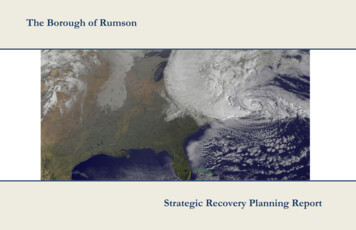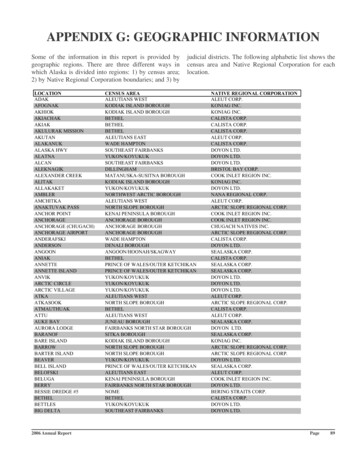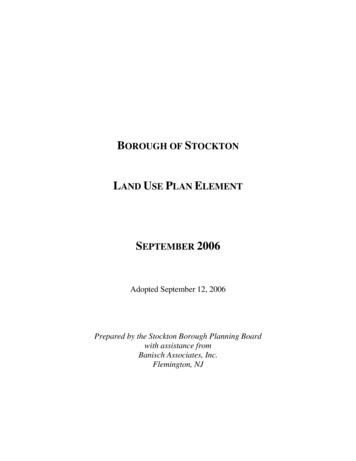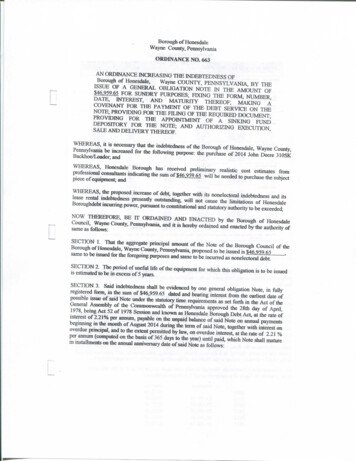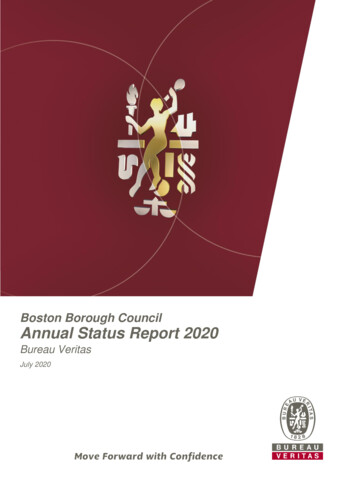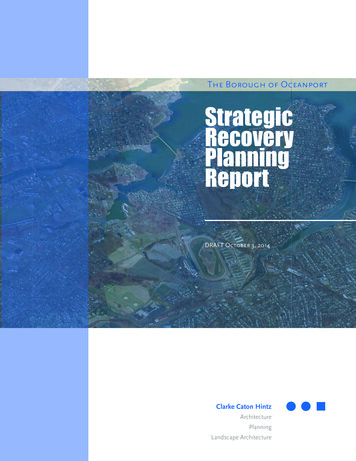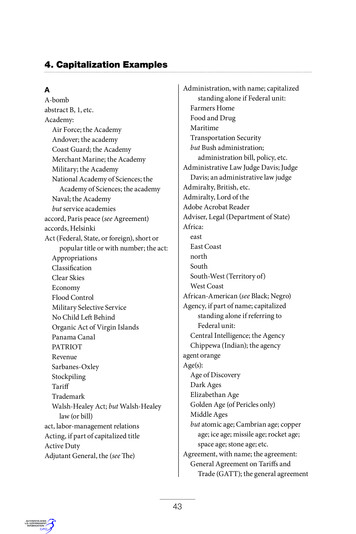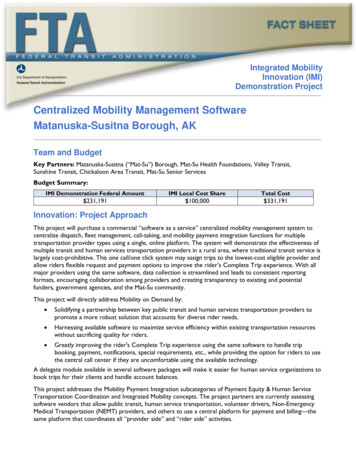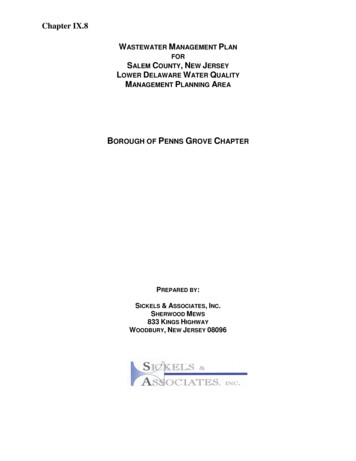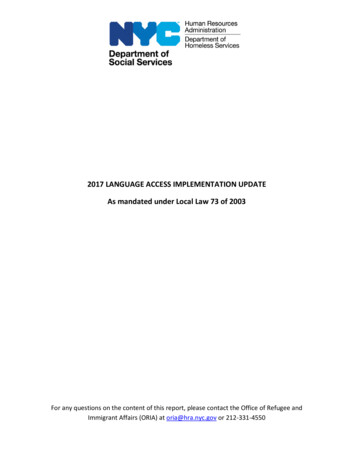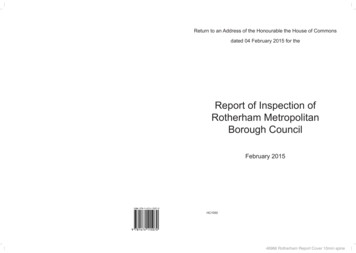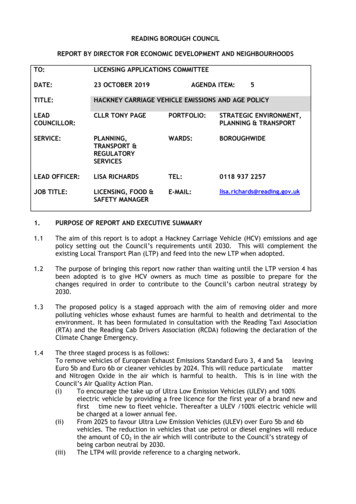
Transcription
READING BOROUGH COUNCILREPORT BY DIRECTOR FOR ECONOMIC DEVELOPMENT AND NEIGHBOURHOODSTO:LICENSING APPLICATIONS COMMITTEEDATE:23 OCTOBER 2019TITLE:HACKNEY CARRIAGE VEHICLE EMISSIONS AND AGE POLICYLEADCOUNCILLOR:CLLR TONY PAGEPORTFOLIO:STRATEGIC ENVIRONMENT,PLANNING & TRANSPORTSERVICE:PLANNING,TRANSPORT ®ULATORYSERVICESWARDS:BOROUGHWIDELEAD OFFICER:LISA RICHARDSTEL:0118 937 2257JOB TITLE:LICENSING, FOOD &SAFETY MANAGERE-MAIL:lisa.richards@reading.gov.ukAGENDA ITEM:51.PURPOSE OF REPORT AND EXECUTIVE SUMMARY1.1The aim of this report is to adopt a Hackney Carriage Vehicle (HCV) emissions and agepolicy setting out the Council’s requirements until 2030. This will complement theexisting Local Transport Plan (LTP) and feed into the new LTP when adopted.1.2The purpose of bringing this report now rather than waiting until the LTP version 4 hasbeen adopted is to give HCV owners as much time as possible to prepare for thechanges required in order to contribute to the Council’s carbon neutral strategy by2030.1.3The proposed policy is a staged approach with the aim of removing older and morepolluting vehicles whose exhaust fumes are harmful to health and detrimental to theenvironment. It has been formulated in consultation with the Reading Taxi Association(RTA) and the Reading Cab Drivers Association (RCDA) following the declaration of theClimate Change Emergency.1.4The three staged process is as follows:To remove vehicles of European Exhaust Emissions Standard Euro 3, 4 and 5a leavingEuro 5b and Euro 6b or cleaner vehicles by 2024. This will reduce particulate matterand Nitrogen Oxide in the air which is harmful to health. This is in line with theCouncil’s Air Quality Action Plan.(i)To encourage the take up of Ultra Low Emission Vehicles (ULEV) and 100%electric vehicle by providing a free licence for the first year of a brand new andfirst time new to fleet vehicle. Thereafter a ULEV /100% electric vehicle willbe charged at a lower annual fee.(ii)From 2025 to favour Ultra Low Emission Vehicles (ULEV) over Euro 5b and 6bvehicles. The reduction in vehicles that use petrol or diesel engines will reducethe amount of CO2 in the air which will contribute to the Council’s strategy ofbeing carbon neutral by 2030.(iii)The LTP4 will provide reference to a charging network.
1.5If this report is agreed by the licence committee it will be forwarded to StrategicEnvironment Planning and Transport committee in November 2019 for information.2.RECOMMENDED ACTION2.1That committee adopt the emissions and age policy for HCVs until 2030 which is setout as follows:DateProposed Standard23 Oct 2019Vehicle Age policy 15 years for all vehicles, 100% electric 20 year Vehicle AgePolicy23 Oct 2019All Replacement vehicles will be a min of Euro 5b and less than 8 years old.This rule will apply regardless of whether the vehicle is new to fleet or anexisting vehicle.1 Oct 2021Vehicle Age Policy 14 years for vehicles up to and including Euro 5a (vehiclesaged over 1/10/07 only)1 Oct 2022Vehicle Age Policy 13 years for vehicles up to and including Euro 5a (vehiclesaged over 1/10/09 only)1 Oct 2023Vehicle Age Policy 12 years for vehicles up to and including Euro 5a (vehiclesaged over 1/10/11 only)1 Oct 2025All Replacement vehicles are minimum ULEV and less than 8 years old. Thisrule will apply regardless of whether the vehicle is new to fleet or an existingvehicle.1 Oct 2028All vehicles to be minimum ULEVDateIncentivesCurrentlyAll 100% electric vehicles pay 41% of the standard vehiclefee.From 1 April 2020All ULEV (CO2 50g/km emissions) pay a 25% reduction inthe annual standard vehicle fee.100% electric vehicles will receive a 50% reduction in theannual standard vehicle fee.1 Oct 2021 -1 Oct 2022Any ULEV/100% electric vehicle that has never been onthe fleet before receives a free licence for its first year onthe fleet.2.2The committee agree a definition of an Ultra Low Emission Vehicle (ULEV) as avehicle emitting a maximum of 50g/km of CO2 from the tailpipe as detailed in theDVLA vehicle specification. This brings forward the national standard definitionwhich is due to come into force from 2021.2.3That committee agree that the HCV emissions and age policy will compliment LTP4,which will acknowledge the greater electric charging infrastructure required toachieve the air quality standards and carbon neutral strategy by 2030.2.4A further report will be brought to full Licensing Committee in Autumn 2020 toreview the vehicle fees and charges for Hackney Carriages to ensure that anyincentives given above are maintained within the current advances of technologyand within the overall budget.2.5Where Government grant money or incentives become available in the future, theCouncil may bring about a revision of the policy to accelerate the move to zeroemissions.
3.POLICY CONTEXT3.1In the UK, road transport is now the largest source of carbon dioxide (CO2) pollution. InJuly 2018, the government set-out its ‘Our road to Zero’ strategy to meet both shortand longer term reductions in CO2 and air quality emissions including ending the sale ofconventional petrol and diesel vehicles by 2040. See reference footnote no. 11.13.2The emissions strategy is more complex than just the reduction of CO2 and involves thereduction of nitrogen oxide (NOx) and particulate matter namely particulate matter ofsize 0.01 mm (PM10) and particulate matter of size of 0.0025 mmm (PM2.5). Both NOxand particulate matter are found in diesel fuel. Particulate matter is also associatedwith tyre, brake and road wear.3.3The European Exhaust Emissions Standard (known as the “Euro” standard) wasintroduced in the 1970s. Limits on CO2, NOx and particulate matter emissions formpart of these standards. The introduction of each new Euro level brings about areduction in carbon, hydrocarbon emissions, NOx and particulate matter from theengines.3.4The most significant reduction in emissions is with the latest Euro 6 engine.3.5Significant further reduction in carbon emissions can be achieved by converting toULEV. An ULEV as defined by the Vehicle Certification Agency is currently a vehiclethat emits less than 75 g/km of CO2 from the tailpipe. The definition of ULEV will bereduced to 50g/km of CO2 from the tailpipe from 2021. These vehicles will be either100% electric or a hybrid model which uses electric in conjunction with either a dieselor petrol engine.3.6Reading Borough Council declared a ‘Climate Emergency’ and set an objective to becarbon neutral by 2030 at its Strategic Environment Planning and Transport (SEPT)Committee on 18 March 2019 following a motion to Full Council on the 26th February2019. In order to achieve this, consideration will need to be given to ensure thatforthcoming revisions to the Local Transport Plan and Climate Change Strategy (and anyother relevant policy statements) reflect the urgency of this resolution.3.7The Office for Low Emission Vehicles (OLEV) has made grant available to dealershipsspecifically for taxis via a ‘plug in taxi grant’. The dealerships can claim between 3000 and 7500 depending on the vehicle type. This amount is deducted from theprice of a new vehicle at the dealership so there is no paperwork to complete by thecustomer. For instance the Dynamo Moto Company taxi which is 100% electric has arange of 174 miles and a price of 52,995 Inc VAT less 7,500 Government grantsleaving 45,495 to pay. The London Electric Vehicle Company which has lower emissionthan a standard taxi but is not 100% electric and is likely be awarded a lower grant of 3000 grant at the dealership.3.8The Department for Transport (DfT) plans to reduce the annual vehicle road tax forULEV vehicles to between 0 - 145 depending on if the vehicle is 100% electric or ifthere is a fuel powered range extender on the vehicle.3.9The Council currently charges a reduced fee of 145 per year to licence a 100% electricvehicle compared to 346 (not including unmet demand fee) for a 100% petrol/dieselvehicle. There has been no take up of this offer to date in the hackney carriage fleetbut there is 1 private hire vehicle.3.10The Air Quality (Taxis and Private Hire Vehicles Database) (England and Wales)Regulations 2019 makes provision of information relating to taxis and private hirevehicles a requirement in order to secure air quality compliance. Licensing Authoritiesin England and Wales will be required to upload weekly details from October 2019 ofthe vehicles licensed by the Council to a central database held by Department of
Environment Farming and Rural Affairs (DEFRA). The DEFRA database will contribute tolocal air quality action plans and Clean Air zones.4.0THE PROPOSAL4.1Current Position:4.1.1 At September 2011 Licensing Committee it was resolved that from 1 October 2013 allHackney Carriage Vehicles must have an engine which is Euro 3 compliant or better orhave been retrofitted with an emission abatement system to achieve Euro 3 standard orhigher.4.1.2 In November 2016 the Licensing Committee resolved to change the emissions policy toan age policy and resolved that a 15 year age policy for all HCVs be introduced from 1stOctober 2018. Any new to fleet vehicles would be a maximum of 8 years old.4.1.3 The following graph details the Euro Emission Standard and the number of vehiclescurrently licensed by the Council at October 2019. The vehicle age and vehicle emissionproduced at each Euro standard is provided in Appendix 1.No of HCV per Euro category (Oct 19)180160140120100806040200345a5b6bULEV4.1.4 The current 15 year age policy means that Euro 4 vehicles will start to be removed fromthe fleet in a graduated manner from January 2021 but all of the Euro 4 vehicles willnot be removed from the fleet until August 2026. Furthermore, Euro 5b and Euro 6bvehicles will not come off the fleet until after the 2030 deadline.4.1.5 There are no ULEV HCVs on the fleet including LPG, electric or hybrid vehicles.4.2Option Proposed4.2.1 The Council proposes the introduction of a new emissions policy that has been agreedby the RTA (see Appendix 2) and sets out a staged approach to remove the older andmore polluting vehicles and to actively encourage the take up of ULEV vehicles by 2030.This is detailed in the table below.DateProposed Standard23 Oct 2019Vehicle Age policy 15 years for all vehicles, 100%electric 20 year age policyAll Replacement vehicles will be a min of Euro 5b andless than 8 years old. This rule will apply regardless of23 Oct 2019Vehicles Removed
1 Oct 202030 Sept 20211 Oct 20211 Oct 20221 Oct 202328 Dec 20241 Oct 20251 Oct 2028whether the vehicle is new to fleet or an existing vehicle.15 year Vehicle Age policy15 year Vehicle Age policyVehicle Age Policy 14 years for vehicles up to andincluding Euro 5a (vehicles aged over 1/10/07 only)Vehicle Age Policy 13 years for vehicles up to andincluding Euro 5a (vehicles aged over 1/10/09 only)Vehicle Age Policy 12 years for vehicles up to andincluding Euro 5a (vehicles aged over 1/10/11 only)Vehicle Age Policy 12 years endsAll Replacement vehicles are minimum ULEV and lessthan 8 years old. This rule will apply regardless ofwhether the vehicle is new to fleet or an existing vehicle.All vehicles to be minimum ULEV8 Euro 320 Euro 3/ Euro 451 vehicles –all Euro 4(1/10/06-30/9/07)77 all Euro 4(1/10/07-30/9/09)32 Euro 4 / 5a(1/10/09-30/9/11)9 Euro 5a4.2.2 The Council will implement the following incentives to HCV owners in order toencourage the take up of the ULEV. The annual standard vehicle fee is to bedetermined each year. Any incentives given below will be regularly reviewed todetermine whether they are within budget and reflect the advances in technology.DateCurrentlyFrom 1 April 20201 Oct 2021 -1 Oct 20224.3IncentivesAll 100% electric vehicles pay 41% of the standard vehiclefee.All ULEV (CO2 50g/km emissions) pay a 25% reduction inthe annual standard vehicle fee.100% electric vehicles will receive a 50% reduction in theannual standard vehicle fee.Any ULEV/100% electric vehicle that has never been onthe fleet before receives a free licence for its first yearon the fleet.Other Options Considered4.3.1 The Council have proposed a change back to an Euro emissions standard policy whichwill remove more polluting vehicles quickly.Date1 April 20201 Oct 20211 Oct 20221 Oct 20261 Oct 20291 Oct 2026Proposed StandardVehicles to be removedMinimum of Euro 4Euro 3 and olderMinimum of Euro 5Euro 4Minimum of Euro 6Euro 5a and 5bAll new vehicles are ULEVAll vehicles to be ULEVEuro 6Any vehicle with petrol/diesel element to their engine willhave a max age policy of 12 years and 8 years at brand newto fleet4.3.2 The RTA sent a representation on 30th September 2019 as follows. See also Appendix 2:DateProposed StandardVehicles to be removedAge limit of 15 years for all Euro 4,5,61 April 2021Minimum of Euro 4Euro 31 Oct 2022All new vehicles Euro 5 orabove
1 Oct 20241 Oct 20261 Oct 2029Age limit of 20 years for ULEVAll new vehicles Euro 6 oraboveAll new vehicles are ULEVAll vehicles to be ULEVEuro 6b4.3.3 The Reading Cab Drivers Association (RCDA) sent a representation as follows on 10thOctober 2019 and Appendix 3.DateProposed Standard1st October 2019-1 Oct 2020Existing15 years policyMinimum 20 years policy4.3.4Minimum Euro 3 TXII 1 year policyAll other models including TX4, MercedesVito modelsAll new vehicles ULEVA response has been received by a hackney carriage driver asking for more plates to beissued. He has made a commitment to bring ULEV vehicles to the fleet if new platesare issued. His email is in Appendix 4.4.3.5 A response from the Council’s Environmental Protection Team on the proposal in 4.2.1is as follows.The policy is an improvement on what is currently in place, but I would like it tobe stronger to bring emissions down more quickly. I suggest: Replacement vehicles being less than 5 years old rather than 812 year age policy to continue after 2023 so that vehicles over 12 years old areremoved from the fleet annually between 2023 and 2028 before all vehicleshave to be ULEV.That said, this proposal is a more balanced compromise between RBCs originalproposal and the RTAs as it speeds up the removal over the oldest dirtiestvehicles and encourages replacement with ULEV vehicles.4.3.6 The Council is also exploring with London Electric Vehicle Company (LEVC) whether itwould be viable to provide a number of ULEV vehicles for short term rent so thatdrivers can become familiar with the ULEV before purchase.4.3.7 In July 2019 Transport for London released a staged approach age policy for their HCVfleet whereby ultimately no vehicle will be older than 12 years by 2022.4.3.8 Manchester and Southampton councils currently have a maximum age policy of 12years. Whereas Birmingham Council has a maximum age policy of 15 years and MiltonKeynes has a maximum age policy of 10 years.4.3.9 Oxford City Council require all Hackney Carriage Vehicles to be a minimum of Euro 4from 1 January 2020, all new vehicles must be ULEV from 1 January 2022 and allvehicles must be ULEV by 1 January 2025.5.CONTRIBUTION TO STRATEGIC AIMS5.1The proposals in the report meet the overall direction of the Council by meeting theCorporate Plan priorities as follows:
1. Securing the economic success of Reading and provision of job opportunities – theCouncil understands that HCVs are an important part of the overall transportstrategy for the town2. Keeping Reading’s environment clean, green and safe – ensuring the reduction inemissions from HCVs and improving the overall air quality within the town.3. Ensuring the Council is fit for the future – implementing the Government andCouncil objectives of a less polluting and lower carbon environment.5.2The decision contributes to the Council’s strategic aims by: Developing Reading as a Green City with a sustainable environment and economy atthe heart of the Thames Valley – reducing the emissions from the HCV fleet willcontribute to a lower carbon footprint for the town. Promoting equality, social inclusion and a safe and healthy environment for all –reducing the emissions from the HCV fleet will reduce the NOx and particulatematter in the air which is associated with poor health outcomes.6.COMMUNITY ENGAGEMENT AND INFORMATION6.1The HCV trade were consulted as the group of individuals who are most affected. TheReading Taxi Association gave their views on the proposal detailed in 4.3.2 andAppendix 2.6.2The Reading Cab Drivers Association (RCDA) have been consulted on this proposal.Their responses to officer’s proposal are detailed in 4.3.3 and Appendix 3.6.3Several meetings were held with the RTA to come up with a further proposal that wouldbe acceptable to all parties.6.4A meeting was held with the RCDA on 9th October 2019 to hear their views andencourage them to put forward a proposal.6.5The Licensing Team have received two communications from Councillors, one fromCouncillor Daya Pal Singh and the other from Councillor Rob White asking for commentsand requesting that the Council consider tackling climate change but in a fair wayrespectively.7.ENVIRONMENTAL IMPLICATIONS7.1The emissions strategy involves the reduction of carbon dioxide and the reduction ofnitrogen oxide (NOx) and particulate matter namely particulate matter of size 0.01 mm(PM10) and particulate matter of size of 0.0025 mmm (PM2.5). Both NOx and particulatematter are found in diesel fuel. Particulate matter is also associated with tyre, brakeand road wear.7.2Reduction in carbon emissions can be achieved by converting to Ultra Low EmissionVehicles (ULEV). These vehicles will be either 100% electric which will emit no CO2,NOx or particulate matter or a hybrid model which uses electric in conjunction witheither a diesel or petrol engine. The diesel or petrol engine will emit some CO2, NOx orparticulates7.3Reading has an Air Quality Management Strategy which covers NOx but also considersPM10 and PM 2.5. There is a current 2015/16 action plan which identifies as one of itscommitments to ‘explore and implement ways to improve emissions from Reading’s taxifleet’. The 2015/16 action plan is in the process of being updated.
7.4Furthermore Reading has been identified by the Department For Transport as failing tomeet the National objective level for NOx of 40µg/m3. The site adjacent to the HackneyCarriage Vehicle rank at the South West Interchange was one of those sites.7.5Health - an improvement in air quality will improve health outcomes for people whowork, live or socialise in Reading. The Reading’s Joint Strategic Needs Assessmentestimated that there were 63 deaths in 2017 of all-cause mortality attributable toanthropogenic particulate air pollution. Whilst levels in Reading do not breach thenational level of particulate PM10 of 40µg/m3, average levels over the monitoring sitesshow 21µg/m3 with 2 of the 3 monitoring sites that have rising annual levels.8.EQUALITY IMPACT ASSESSMENT8.1The decision will impact hackney carriage owners more than any other group of people.9.LEGAL IMPLICATIONS9.1The Local Government (Miscellaneous Provisions) Act 1976, section 47(1) states that aDistrict Council may attach to the grant of a licence of a HCV under the Town ClausesAct 1847 such conditions as the district Council may consider reasonably necessary.Section 47(2) states that without prejudice to the generality of the foregoingsubsection, a district council may require any HCV licensed by them under the 1847 Actto be of such a design or appearance or bear such distinguishing marks as shall clearlyidentify it as a HCV. Section 47 (3) states that any person aggrieved by any conditionsattached to such a licence may appeal to a Magistrates’ Court.10.FINANCIAL IMPLICATIONS10.1All HCVs must be licensed annually and will require a similar amount of staffing in orderto process the licence and carry out the enforcement action. The amount ofenforcement action will be similar for ULEV as for 100% fuel vehicles. The Council willreceive a lower income from owners who purchase a ULEV. It is anticipated this willhappen gradually between 2021 and 2029 but will peak in the years where a freelicence is offered.10.2The financial implications arising from the proposals set out in this report are set outbelow. The running costs will reduce slightly with processing efficiencies.It should be noted that officers are currently conducting further analysis of fees which is likelyto change the income. These figures will need to be re-profiled once new fees have been set.1.Revenue ImplicationsEmployee costsOther running costsCapital financings costsExpenditureIncome from:Fees and chargesBased on 231 annual HCV licencesEstimate no of HCV converting toULEV2019/21 - 0 ULEV2019/20 0002020/21 0002021/22 000 69,000 12,000 70,500 10,000 72,000 8,000 81,000 80,500 80,000- 80,388- 76,039- 70731
2020/21 - 50 ULEV2021/22 - 111 ULEV2022/23 - 5 ULEV2023/24 - 5 ULEV2024/25 – 5 ULEV2025/26 - 5 ULEV2026/27 – 50 ULEVTotal Income- 80,388- 76,039- 70731 612 3,961 9,269Net Cost( )/saving (-)The net cost of the proposal can be funded from Licensing budget.11.BACKGROUND PAPERS11.1Vehicle Certification Agency (Sept 2018) New Car Fuel Consumption and EmissionFiguresAppendix 1 - The emission standard compared to the age of the vehicle is given below.EuroEmission Std3Registration DateEmission levelsJan 01 - Dec 054Jan 06- Dec 105aJan 11-Dec 125bJan 13-Aug 156Sep 15- 2017ULEV2017CO- 0.64 g/kmNOx - 0.5 g/kmPM –0.05 g/kmCO- 0.5 g/kmNOx - 0.25 g/kmPM –0.025 g/kmCO- 0.5 g/kmNOx - 0.18 g/kmPM –0.025 g/kmCO- 0.5 g/kmNOx - 0.18 g/kmPM –0.005 g/kmCO- 0.5 g/kmCO2 – 130 g/kmNOx - 0.08 g/kmPM –0.005 g/kmCO2 – 50 g/km
Appendix 2 – representations from RTA
Email from Asif Rashid, Chair of RTA on Thu 10/10/2019 19:41Dear LisaThank you for your email.Following our discussions, I can confirm that the RTA is in agreement with theemissions proposal as outlined in your email which was agreed between us earlier todayIf you need anything else please do not hesitate to contact me.Best wishesAsifSent from Samsung Galaxy S10 On Thu, 10 Oct 2019, 17:45 Richards, Lisa, lisa.richards@reading.gov.uk wrote:Dear AsifHere is the proposal that we agreed today. I have amended 1/10/25 replacement ULEV to beclearer.DateProposed Standard23 Oct 2019Age policy 15 years for all vehicles, 100% electric 20 year age policy23 Oct 2019All Replacement vehicles will be a min of Euro 5b and less than 8 years old. This rule will applyregardless of whether the vehicle is new to fleet or an existing vehicle.1 Oct 2021Age limit 14 years for vehicles up to and including Euro 5a (vehicles aged over 1/10/07 only)1 Oct 2022Age limit 13 years for vehicles up to and including Euro 5a (vehicles aged over 1/10/09 only)1 Oct 2023Age limit 12 years for vehicles up to and including Euro 5a (vehicles aged over 1/10/11 only)1 Oct 2025All Replacement vehicles are minimum ULEV and less than 8 years old. This rule will applyregardless of whether the vehicle is new to fleet or an existing vehicle.1 Oct 2028
All vehicles to be ULEVBest WishesLisaLisa Richards MCIEH CEnvHLicensing, Food & Safety ManagerRegulatory Services Directorate for Economic Growth and Neighbourhood ServicesReading Borough CouncilCivic OfficesBridge StreetReadingRG1 2LUAppendix 3 – representations from RCDAEmail dated 6th October 2019Dear Ms RichardsFurther to your email regarding the emissions policy which are being proposed by RBC for theHackney Carriage trade. We regret to inform you that these changes are not acceptable to thetrade and we believe that this matter hasn’t been given careful consideration I would requestthat you look into this matter again taking our points and views to consideration.We strongly believe that the 15 year rule which was only passed year or so ago by thecommittee should continue as it is stands and owners will have enough time to arrange for anelectric vehicle when the age limit is over on there current taxis. I would also like to add thatnot enough is being done to protect our hackney carriage trade, you have apps like Ola, Uberand the local private hire who continuously illegally ply for hire and taking away our work, thisputs a huge pressure on our earning and therefore we cannot afford to keep changing our taxis.This new policy will put a huge financial burden on our trade and we cannot see how the tradewill be able to meet the new requirements. Owners have recently purchased new taxis justover a year ago (and or) less than a year ago at considerable costs. Under the current proposalsthe trade will be required to purchase either a Euro 6 taxi which will cost between 40,000 to 60,000 to buy, the new electric taxi which will cost over 60,000 when hire purchasepayments are taken into account. This is simply not affordable especially when not knowingwhat will happen with Brexit.The current policy has been in force for less than a year, and a new policy will be the thirdsuch policy to come into operation for the taxi trade in Reading in the last six years.RBC cannot keep changing emissions policies which keep on effecting us, also the numbers oftaxis in Reading is a very small compared to all other road users when taken into account.We realise that currently there is a big emphasis on climate change and pollution and we allneed to play our part in reducing this and we are prepared to do this. However this should notbe done where it becomes impossible for us to continue working as taxi drivers.I hope that you will take our concerns into count and we hope that a new policy will be onethat is mutually acceptable to both the council and to the taxi owners. We would urge you togive our proposal serious consideration.
Thank you and I look forward hearing from you.RegardsRCDAFurther email on 10th October 2019Dear Ms Lisa RichardsPlease find attached our proposal that we would like to put forward.Tx21 year from 1st October 2019 to 1st October 2020Tx4 Euro 4 Existing 15 year policyMercedes Vito Euro 5 and euro 6 tx4 euro 5 and euro 6 Existing 15 year policy.All new electric taxis ULEV Minimum of 20 year policy.The trade have just recently updated and purchased newer cabs because of the 15 year rulewhich you implemented over a year ago. You should honour this rule which would give us timeto adjust, its totally unreasonable to expect the trade to invest 70,000 plus in such a shortperiod time when they have not even had time to clear there current vehicle finances.Please take our views to consideration and hope to here from you. Please do get in touch if youwould like like to discuss anything further.Regards.RCDAAppendix 4:Dear Lisa Richard,We are no of drivers who been working in reading borough as a rental taxi drivers morethen ten years. Many time we tried to explain to the licensing officers and licensingcommittee about our difficulties, and requested for issues more Hackney cab license tothe deserving drivers who been working here more then ten years, but we beenignored .We request to you that as a low emissions cabs are available electric ones , if thecouncil issue us cab license we will bring new electric cabs , and that will help us as ajob security, and will help to clear pollution .I would like to attend any meeting which will be held in this month regarding lowemissions .Please let me know if I can have a meeting with you regarding new Hackney licences.
This rule will apply regardless of whether the vehicle is new to fleet or an existing vehicle. 1 Oct 2021 Vehicle Age Policy 14 years for vehicles up to and including Euro 5a (vehicles aged over 1/10/07 only) 1 Oct 2022 Vehicle Age Policy 13 years for vehicles up to and including Euro 5a (vehicles aged over 1/10/09 only) 1 Oct 2023 Vehicle Age .
